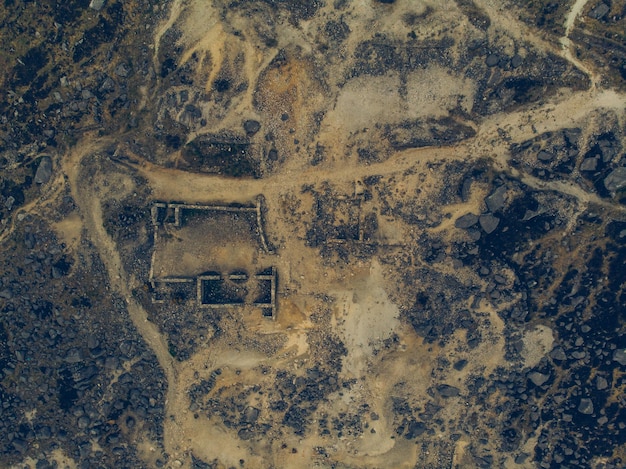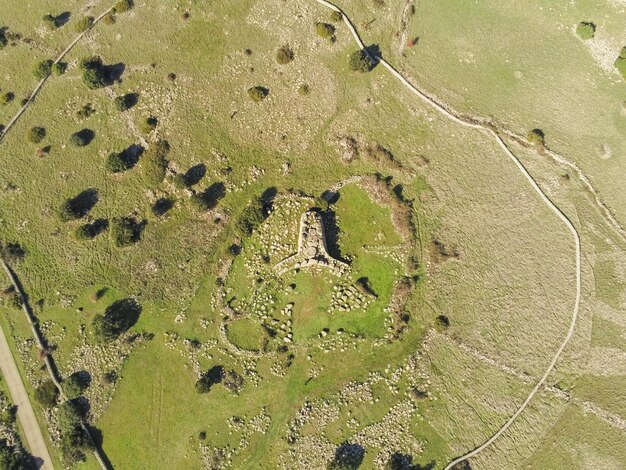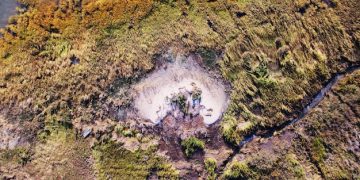Preserving Archaeological Sites on Private Land in the US

Preserving archaeological sites on private land in the U.S. involves a complex interplay of state and federal laws, landowner rights, and various incentives, requiring detailed understanding and proactive engagement to protect historical resources.
Delving into the intricate world of cultural heritage, the challenge of Preserving Archaeological Sites on Private Land: Understanding the Laws and Incentives for Landowners in the US presents a fascinating and often complex landscape. How can we ensure the protection of invaluable historical treasures when they rest on privately-owned tracts?
The Intersection of History and Private Property
The United States, with its rich and layered history, is home to countless archaeological sites. Many of these silent witnesses to past lives and civilizations lie hidden beneath the soil of privately-owned properties. This presents a unique challenge: balancing the rights of property owners with the public’s interest in preserving cultural heritage. It’s a delicate dance between individual liberty and collective responsibility.
Understanding the legal framework is the first step toward effective preservation. Unlike some countries where all archaeological finds immediately become state property, U.S. law generally grants landowners significant rights over what is found on their land. However, this doesn’t mean private land is entirely unregulated when it comes to historical resources. A patchwork of federal, state, and local laws, combined with voluntary programs, attempts to navigate this complex terrain. The challenge often lies in awareness and education, ensuring landowners understand the significance of potential sites and the mechanisms available for their protection.
Defining Archaeological Sites and Their Significance
What exactly constitutes an archaeological site? It’s more than just a collection of old artifacts. It’s a place where human activity has left physical evidence, offering clues about past cultures, technologies, and environments. These sites range from ancient Native American villages and burial mounds to colonial settlements, battlefields, industrial ruins, and even more recent historical landscapes. Each site, regardless of its grandeur, holds a piece of universal human history, offering invaluable insights for research, education, and cultural identity.
Their significance lies not just in the objects found, but in the context. The spatial relationship of artifacts, features, and environmental data tells a story that isolated items cannot. Once disturbed or destroyed, this context is lost forever, making preservation efforts crucial. The scientific and cultural value of these sites extends far beyond academic interest; they are tangible links to our shared heritage.
- Educational Value: Archaeological sites are open-air classrooms, teaching us about human adaptability, resilience, and diversity across millennia.
- Cultural Identity: For many communities, these sites are sacred places or vital components of their cultural narrative and identity.
- Scientific Research: They provide empirical data for understanding human evolution, historical migration patterns, climate change impacts, and societal development.
Ultimately, the preservation of archaeological sites on private land is a testament to a society’s commitment to its past, present, and future. It requires a collaborative spirit, where landowners, archaeologists, government agencies, and the public work together to safeguard these irreplaceable resources for generations to come.
Federal Laws and Their Limited Reach on Private Land
While many envision federal protection for all historical sites, the reality on private land is more nuanced. Federal archaeological laws, such as the National Historic Preservation Act (NHPA) and the Archaeological Resources Protection Act (ARPA), primarily apply to federally-owned or controlled lands, or to projects that receive federal funding or require federal permits. This means that a significant portion of the nation’s historical resources, those on private property without federal nexus, falls outside the direct regulatory scope of these powerful laws.
Navigating the National Historic Preservation Act (NHPA)
The NHPA (1966, as amended) is a cornerstone of historic preservation in the U.S. Its Section 106 is particularly relevant, requiring federal agencies to consider the effects of their undertakings on historic properties. An “undertaking” can include construction projects, land management activities, or even permitting decisions. If a proposed project on private land requires a federal permit (e.g., from the Army Corps of Engineers for wetland disturbance) or receives federal funds, then Section 106 review is triggered, potentially leading to the identification and protection of archaeological sites.
However, if a private landowner undertakes a project on their property without any federal involvement, Section 106 does not apply. This is a critical distinction that often surprises the public. The NHPA’s primary mechanism for private land preservation is therefore indirect, relying on the presence of a “federal nexus” or a federal connection to the activity.
Understanding the Archaeological Resources Protection Act (ARPA)
ARPA (1979) focuses specifically on archaeological resources, enhancing the penalties for excavating, removing, damaging, or otherwise altering archaeological resources on public or Indian lands without a permit. It also prohibits the sale, purchase, or exchange of archaeological resources removed illegally from these lands. While ARPA is a robust tool for protecting federally-owned sites, its jurisdiction generally does not extend to private lands unless the resources found were originally removed illegally from public or Indian lands.
This means that simply finding an artifact or even an entire site on one’s own private land does not automatically trigger ARPA. The act is designed to deter looting and unauthorized excavation on government-owned and tribal lands. For landowners, understanding this distinction is crucial. Many state laws, however, do offer some level of protection for archaeological sites regardless of land ownership, often through designation programs or specific regulations concerning burial sites. The federal framework, while comprehensive for public lands, leaves a gap that state and local initiatives often attempt to fill for private holdings.
- Federal Agencies: Responsible for identifying and protecting resources on their managed lands.
- Permitting Process: A key trigger for Section 106 review on private land.
- Looting Penalties: ARPA’s primary deterrent for unauthorized activities on public land.
In essence, federal laws serve as a foundational layer, but their direct impact on private land is circumscribed. Effective preservation in these contexts often relies on the cooperation of landowners and the existence of a strong supportive network of state and local programs, as well as non-profit organizations dedicated to cultural heritage.
State and Local Regulations: A Patchwork of Protections
Where federal laws often fall short on private land, state and local regulations frequently step in to fill the void. These laws vary significantly from state to state and even from county to county, creating a complex and sometimes confusing patchwork of protections. While some states have robust legislation, others offer minimal safeguards, reflecting diverse priorities and historical contexts. Landowners must therefore research the specific laws applicable to their property’s location.
State-Specific Archaeological Laws
Many states have their own versions of historic preservation and archaeological resource protection acts. These state laws can:
- Require permits for archaeological investigations on private land.
- Protect unmarked burials or human remains discovered during construction or other activities.
- Establish state registers of historic places, which may include archaeological sites on private land.
- Provide tax incentives or grants for preservation efforts.
Some state laws, for instance, mandate archeological surveys for certain types of development projects, regardless of federal involvement, especially if state funds are used or if the project exceeds a certain size threshold. Others focus on protecting specific types of sites, such as Native American cultural properties or historic battlefields. The effectiveness of these laws often depends on the state’s capacity for enforcement and the level of public awareness and buy-in.

Local Ordinances and Zoning
Beyond state laws, local governments—cities and counties—can enact ordinances that influence archaeological site preservation. These can include:
- Historic Preservation Ordinances: Many municipalities have these, which can designate historic districts or individual landmarks, potentially including archaeological sites, and regulate modifications to them.
- Zoning Regulations: Some zoning laws might require archaeological surveys as part of the permitting process for large-scale developments, particularly in areas known to have high archaeological potential.
- Environmental Review Processes: Local environmental review processes, similar to federal NEPA requirements, might also mandate an assessment of cultural resources before project approval.
The enforceability and strictness of these local regulations vary widely. In some areas, local governments might require developers to fund archaeological investigations or to modify development plans to avoid significant sites. In others, such provisions are non-existent or rarely enforced. This decentralized approach means that a landowner in one county might face very different requirements than someone in an adjacent county, even if their properties are similar. It underscores the importance of local inquiry and engagement.
Navigating this legal landscape requires diligence. Landowners potentially sitting on archaeological sites should consult with their State Historic Preservation Office (SHPO), local planning departments, or specialized legal counsel. Only by understanding the specific regulations applicable to their property can they make informed decisions about its long-term management and the preservation of its cultural heritage.
Incentives for Landowners: Encouraging Voluntary Preservation
Given the limited direct regulatory power over archaeological sites on private land, encouraging voluntary preservation through incentives plays a crucial role. These incentives aim to balance the private property rights of landowners with the public interest in protecting cultural resources, offering benefits that can offset potential burdens. They can range from financial assistance and tax breaks to technical support and public recognition.
Financial and Tax Incentives
Perhaps the most direct way to encourage preservation is through financial incentives.
- Grants: Various federal programs, managed by agencies like the National Park Service (NPS), and many state and local historical societies offer grants for archaeological survey, excavation, and preservation activities on private land. These grants can help offset the costs associated with studying or protecting a site.
- Tax Benefits for Conservation Easements: Landowners can donate a conservation easement to a qualified land trust or government entity. This legally enforceable agreement restricts future development on the property to protect its conservation values, which can include archaeological sites. In return, the landowner may be eligible for federal income tax deductions, estate tax benefits, and sometimes state tax credits. This is a powerful tool for long-term preservation as easements typically run in perpetuity.
- Property Tax Relief: Some states or localities offer reduced property taxes for properties that are designated as historic or have preservation easements, recognizing the public benefit of their protected status.
These financial mechanisms aim to make preservation a more attractive option, turning a potential burden into a beneficial decision for the landowner. The reduction in taxes or direct funding can compensate for the limitations placed on the property’s use or development potential.
Technical Assistance and Recognition Programs
Beyond financial incentives, technical assistance and programs that offer recognition and support can be highly effective.
- Technical Support from SHPO/THPO: State Historic Preservation Offices (SHPOs) and Tribal Historic Preservation Offices (THPOs) often provide free technical assistance to landowners. This can include advice on identifying and evaluating archaeological sites, developing preservation plans, or navigating permitting processes. They can also connect landowners with qualified archaeologists.
- National Register of Historic Places Listing: While listing a property on the National Register does not impose restrictions on private landowners unless federal funding or permits are involved, it offers significant prestige and may open doors to certain grant programs or tax incentives. It formally recognizes the site’s historical significance.
- Easement Programs and Land Trusts: Non-profit land trusts often work with landowners to acquire conservation easements or even purchase significant archaeological properties outright. They can also offer expertise in long-term site management and stewardship.
- Archaeological Site Stewardship Programs: In some areas, volunteer stewardship programs exist where trained individuals monitor sites on private land with landowner permission, helping to prevent looting and erosion.
These non-monetary incentives often appeal to landowners who are already inclined towards preservation but need expert guidance or reassurance. They foster a collaborative environment where landowners are seen as partners in cultural heritage management rather than adversaries. The success of voluntary preservation hinges on these varied incentives, demonstrating that safeguarding history can align with a landowner’s personal and financial interests.
Best Practices for Landowners with Archaeological Sites
Discovering an archaeological site on one’s property can be both exciting and daunting. For landowners, adopting best practices can ensure the responsible stewardship of these invaluable resources, preventing damage and maximizing opportunities for preservation and understanding. It involves a combination of awareness, caution, and proactive engagement.
Initial Steps Upon Discovery
When a potential archaeological site is identified, whether through surface finds or during construction, the immediate steps are crucial.
- Stop Work (if applicable): If discovery occurs during ground-disturbing activities, immediately halt work in the vicinity of the find. Further disturbance risks destroying vital contextual information.
- Limit Disturbance: Avoid moving, collecting, or cleaning artifacts. Leave them in place; their exact location and association with other items are critical for interpretation. Document the precise location of the find.
- Contact the Experts: Reach out to your State Historic Preservation Office (SHPO) or a qualified professional archaeologist. They can help assess the significance of the find and advise on the next steps. They can also explain local regulations and available incentives. For Native American sites, involving local tribal nations or the Tribal Historic Preservation Office (THPO) is often appropriate and legally mandated in some contexts.
- Document and Record: Take clear photographs of the discovery in situ, noting observable details like stratigraphy (soil layers) and associations with other objects or features. A simple sketch map can also be helpful.
Resist the urge to “dig to see what’s there.” Amateur excavation, no matter how well-intentioned, almost always results in the irreversible loss of scientific data. Professional archaeologists are trained to systematically record and analyze sites, extracting maximum information while minimizing damage.
Long-Term Site Stewardship and Management
Once a site is identified, long-term stewardship involves ongoing care and management.
- Site Protection: Implement measures to protect the site from erosion, unauthorized digging (looting), and accidental damage. This might involve fencing, signage (with discretion to avoid attracting looters), or simply avoiding ground disturbance in sensitive areas.
- Education and Awareness: Learn about the site’s history and significance. This personal connection can be a powerful motivator for preservation. Share knowledge with family and trusted neighbors to foster a community of stewardship.
- Conservation Easements and Agreements: Consider establishing a conservation easement or entering into a voluntary preservation agreement with a land trust or historic preservation organization. These tools can provide long-term legal protection for the site and may offer tax benefits.
- Ongoing Monitoring: Periodically monitor the site for any signs of disturbance, erosion, or new finds. Report any concerns to the appropriate authorities.
Responsible land management can go hand-in-hand with archaeological preservation. For example, implementing erosion control measures benefits both agricultural operations and site integrity. By seeing archaeological sites as assets rather than liabilities, landowners become critical partners in safeguarding the nation’s past. Their conscious efforts ensure that these non-renewable resources will be available for future generations to study and appreciate.
Challenges and Complexities in Preservation Efforts
Despite growing awareness and various mechanisms, preserving archaeological sites on private land remains fraught with challenges. The very nature of private property rights, coupled with financial, practical, and ethical considerations, creates significant hurdles for effective widespread cultural resource protection.
Balancing Property Rights and Public Interest
At the heart of the challenge is the tension between an individual’s right to control their private property and the collective public interest in preserving non-renewable historical resources. Landowners often view their property as a personal domain, subject solely to their discretion. The idea of external regulation or public access can be seen as an infringement on these rights. This perspective can lead to resistance towards identification efforts or the imposition of preservation mandates.
Furthermore, development pressures can easily override preservation concerns. An archaeological site might be located precisely where a homeowner wants to build an addition, or where a developer plans a new subdivision. The economic value of developing land often far outweighs the perceived value of preserving an archaeological site, especially if no significant financial incentives are offered as compensation. This inherent conflict requires delicate negotiation and creative solutions that respect both property rights and historical significance.
Funding and Resource Limitations
Another significant barrier is the perennial issue of funding and resources. Archaeological work—survey, excavation, analysis, and curation—is expensive. Government agencies, non-profits, and educational institutions often face budget constraints, limiting their ability to purchase properties with archaeological sites or to fund large-scale preservation initiatives on private land.
For landowners, the cost of adhering to preservation guidelines, such as modifying construction plans or funding archaeological surveys, can be prohibitive without external assistance. Many landowners lack the financial means or knowledge to manage a site properly. This disparity between the scale of archaeological resources and the funds available for their protection is a major impediment. Moreover, there’s a scarcity of professional archaeologists and cultural resource specialists in some regions, making it difficult for landowners to find qualified assistance when needed.

Ethical Considerations and Stakeholder Engagement
Ethical complexities also abound when dealing with archaeological sites, particularly those of Native American origin. These sites are not merely scientific data points; they are often sacred places, ancestral cemeteries, or vital components of living cultural heritage. Ensuring respectful treatment and appropriate consultation with descendant communities, especially tribal nations, is paramount, but can complicate development or research plans.
Looting and vandalism remain pervasive threats. The illegal trade in artifacts fuels destructive activities, making it difficult to protect sites even when landowners are willing. Secrecy sometimes arises from fear of attracting looters or burdensome regulations, inadvertently hindering preservation efforts. Effective preservation requires engaging a diverse array of stakeholders—landowners, archaeologists, government agencies, tribal nations, developers, and the broader public—each with their own interests and perspectives. Building consensus and fostering collaboration among these groups is a continuous and complex undertaking, crucial for the long-term viability of archaeological heritage on private lands across the U.S.
Future Directions: Collaborative Preservation Strategies
As we look to the future, the preservation of archaeological sites on private land in the U.S. will increasingly rely on collaborative strategies. Acknowledging the limitations of regulatory approaches alone, the emphasis must shift towards fostering partnerships, innovation, and a mutual understanding of shared responsibility. This means developing more flexible and appealing programs that genuinely benefit landowners while safeguarding heritage.
Enhancing Partnerships and Public Awareness
One of the most promising avenues for improved preservation lies in strengthening partnerships. This includes closer collaboration among federal, state, and local governments, non-profit land trusts, academic institutions, and tribal nations. By pooling resources, expertise, and political will, these entities can offer more comprehensive support to landowners. For example, joint grant programs or coordinated outreach efforts can significantly amplify impact.
Public awareness is also critical. Many landowners are simply unaware that valuable archaeological sites might exist on their property or that resources are available to help them. Educational campaigns that highlight the importance of cultural heritage, explain legal responsibilities, and showcase successful preservation stories can empower landowners to become active stewards. Field schools, public archaeology programs, and community workshops can also foster a sense of connection and ownership over local historical resources.
Innovative Incentives and Technology
The development of new and more attractive incentives is essential. Beyond traditional tax breaks and grants, this might involve:
- Transferable Development Rights (TDRs): Allowing landowners who preserve sites on their property to sell development rights to developers in other, less sensitive areas.
- Eco-tourism and Heritage Tourism: Developing programs that allow landowners to generate income through managed access to archaeological sites, where appropriate and culturally sensitive. This could turn a “liability” into an economic asset.
- Easier Access to Expertise: Streamlining the process for landowners to connect with archaeological professionals and receive free, confidential advice.
Technological advancements also offer exciting possibilities. Remote sensing techniques (like LiDAR and ground-penetrating radar) can identify potential sites without intrusive digging, allowing for proactive planning. Drone imagery and Geographic Information Systems (GIS) can help landowners understand and map the archaeological potential of their property. Digital platforms can facilitate communication, resource-sharing, and community engagement, connecting landowners with a network of support.
Ultimately, the future of archaeological preservation on private land depends on recognizing that it is a shared endeavor. It’s not just about compliance with laws, but about building relationships, fostering a sense of shared heritage, and providing practical, beneficial choices for landowners. By creating a landscape where preservation is seen as a smart and celebrated decision, we can ensure that the stories buried beneath our feet continue to inform and enrich generations to come.
| Key Point | Brief Description |
|---|---|
| 📜 Legal Frameworks | Federal laws primarily cover public/federally-funded lands, while state/local laws offer varied protections for private property. |
| 💰 Landowner Incentives | Financial incentives (grants, tax benefits) and technical assistance encourage voluntary preservation. |
| 🏡 Best Practices | Stop work on discovery, contact experts, limit disturbance, and explore long-term stewardship options. |
| 🤝 Collaborative Future | Future efforts need stronger partnerships, public awareness, and innovative incentives to ensure preservation. |
Frequently Asked Questions About Preserving Archaeological Sites
▼
Federal laws like the National Historic Preservation Act (NHPA) and the Archaeological Resources Protection Act (ARPA) primarily apply when a project has a “federal nexus” (e.g., federal funding, permits, or takes place on federal lands). If a private landowner undertakes an activity with no federal involvement, these laws generally do not apply, shifting regulatory responsibility to state or local statutes.
▼
If you find an artifact, it’s crucial to stop any digging or disturbance in the area. Leave the artifact in place, document its location with photos, and then contact your State Historic Preservation Office (SHPO) or a qualified archaeologist. They can assess the find, advise on its significance, and guide you on the appropriate next steps for identification and potential preservation.
▼
Yes, landowners can be eligible for tax benefits, primarily through donating a conservation easement to a qualified land trust or governmental entity. This perpetual agreement restricts development to protect the site’s value, potentially leading to federal income tax deductions, estate tax benefits, and sometimes state property tax relief. Consult a financial advisor for specific details.
▼
The legality of selling artifacts found on private land is complex and varies by state. While federal laws like ARPA prohibit the sale of artifacts illegally removed from public or Indian lands, private land finds may fall under different rules. It’s advisable to consult with your State Historic Preservation Office or legal counsel to understand specific state laws concerning archaeological artifact ownership and sale before engaging in any transactions.
▼
Long-term protection involves several strategies. Consider a conservation easement, which legally protects the site in perpetuity. You can also implement physical protection measures, such as fencing or strategic landscaping, and engage in ongoing monitoring to deter looting or accidental damage. Connecting with local historical societies or archaeology groups can provide valuable support and resources for stewardship.
Conclusion
The preservation of archaeological sites on private land in the U.S. is a shared responsibility, a critical nexus where individual property rights meet the collective historical legacy. While federal laws have limited direct reach, a dynamic interplay of state and local regulations, coupled with a growing array of landowner incentives, provides a framework for safeguarding these irreplaceable resources. Understanding these mechanisms, proactively engaging with experts, and embracing collaborative stewardship are paramount. For landowners, recognizing the profound historical value beneath their feet and utilizing available support can transform potential challenges into opportunities for significant contribution to our shared heritage, ensuring that the stories of the past continue to resonate for generations to come.





